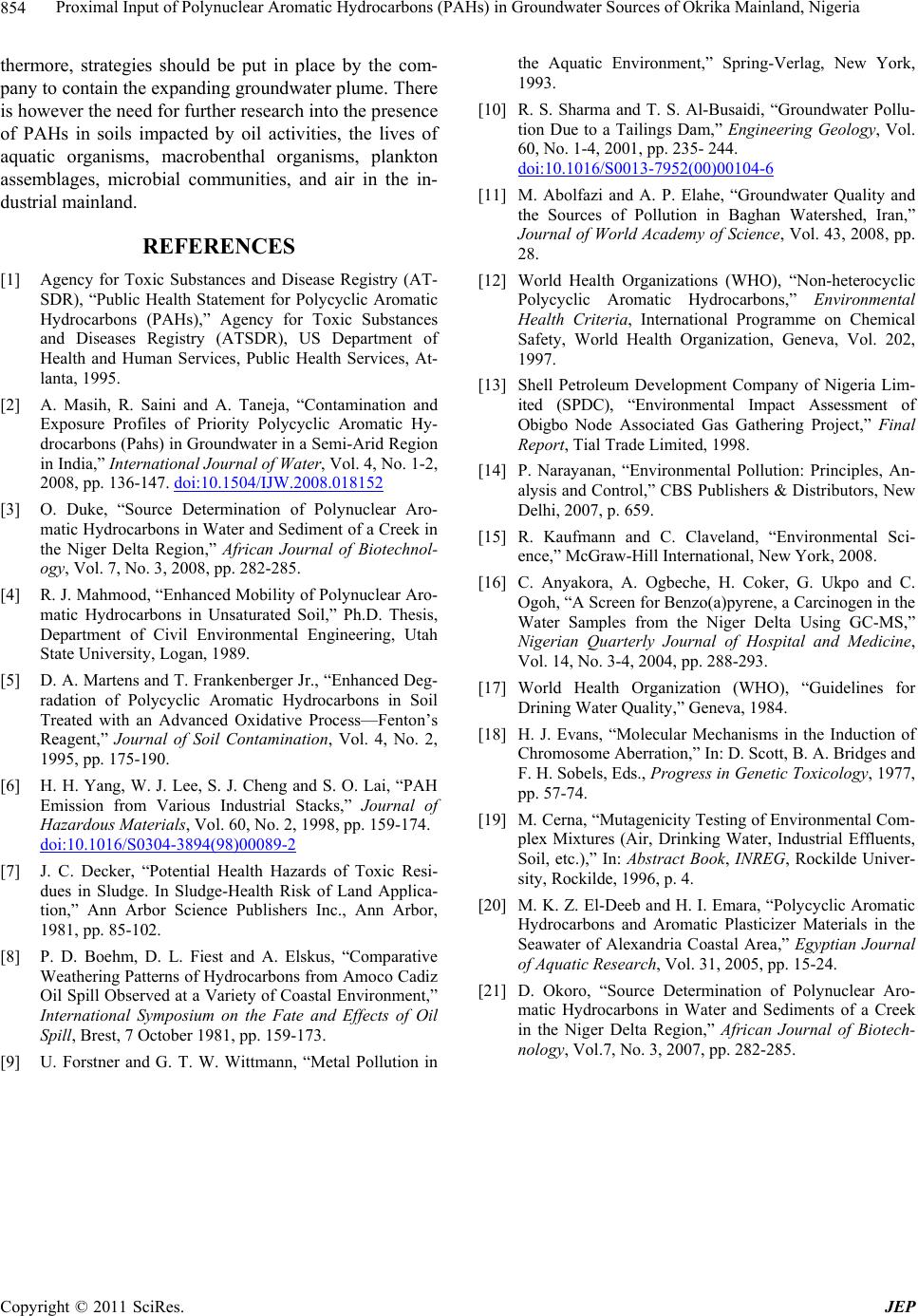
Proximal Input of Polynuclear Aromatic Hydrocarbons (PAHs) in Groundwater Sources of Okrika Mainland, Nigeria
854
thermore, strategies should be put in place by the com-
pany to contain the expanding groundwater plume. There
is however the need for further research into the presence
of PAHs in soils impacted by oil activities, the lives of
aquatic organisms, macrobenthal organisms, plankton
assemblages, microbial communities, and air in the in-
dustrial mainland.
REFERENCES
[1] Agency for Toxic Substances and Disease Registry (AT-
SDR), “Public Health Statement for Polycyclic Aromatic
Hydrocarbons (PAHs),” Agency for Toxic Substances
and Diseases Registry (ATSDR), US Department of
Health and Human Services, Public Health Services, At-
lanta, 1995.
[2] A. Masih, R. Saini and A. Taneja, “Contamination and
Exposure Profiles of Priority Polycyclic Aromatic Hy-
drocarbons (Pahs) in Groundwater in a Semi-Arid Region
in India,” International Journal of Water, Vol. 4, No. 1-2,
2008, pp. 136-147. doi:10.1504/IJW.2008.018152
[3] O. Duke, “Source Determination of Polynuclear Aro-
matic Hydrocarbons in Water and Sediment of a Creek in
the Niger Delta Region,” African Journal of Biotechnol-
ogy, Vol. 7, No. 3, 2008, pp. 282-285.
[4] R. J. Mahmood, “Enhanced Mobility of Polynuclear Aro-
matic Hydrocarbons in Unsaturated Soil,” Ph.D. Thesis,
Department of Civil Environmental Engineering, Utah
State University, Logan, 1989.
[5] D. A. Martens and T. Frankenberger Jr., “Enhanced Deg-
radation of Polycyclic Aromatic Hydrocarbons in Soil
Treated with an Advanced Oxidative Process—Fenton’s
Reagent,” Journal of Soil Contamination, Vol. 4, No. 2,
1995, pp. 175-190.
[6] H. H. Yang, W. J. Lee, S. J. Cheng and S. O. Lai, “PAH
Emission from Various Industrial Stacks,” Journal of
Hazardous Materials, Vol. 60, No. 2, 1998, pp. 159-174.
doi:10.1016/S0304-3894(98)00089-2
[7] J. C. Decker, “Potential Health Hazards of Toxic Resi-
dues in Sludge. In Sludge-Health Risk of Land Applica-
tion,” Ann Arbor Science Publishers Inc., Ann Arbor,
1981, pp. 85-102.
[8] P. D. Boehm, D. L. Fiest and A. Elskus, “Comparative
Weathering Patterns of Hydrocarbons from Amoco Cadiz
Oil Spill Observed at a Variety of Coastal Environment,”
International Symposium on the Fate and Effects of Oil
Spill, Brest, 7 October 1981, pp. 159-173.
[9] U. Forstner and G. T. W. Wittmann, “Metal Pollution in
the Aquatic Environment,” Spring-Verlag, New York,
1993.
[10] R. S. Sharma and T. S. Al-Busaidi, “Groundwater Pollu-
tion Due to a Tailings Dam,” Engineering Geology, Vol.
60, No. 1-4, 2001, pp. 235- 244.
doi:10.1016/S0013-7952(00)00104-6
[11] M. Abolfazi and A. P. Elahe, “Groundwater Quality and
the Sources of Pollution in Baghan Watershed, Iran,”
Journal of World Academy of Science, Vol. 43, 2008, pp.
28.
[12] World Health Organizations (WHO), “Non-heterocyclic
Polycyclic Aromatic Hydrocarbons,” Environmental
Health Criteria, International Programme on Chemical
Safety, World Health Organization, Geneva, Vol. 202,
1997.
[13] Shell Petroleum Development Company of Nigeria Lim-
ited (SPDC), “Environmental Impact Assessment of
Obigbo Node Associated Gas Gathering Project,” Final
Report, Tial Trade Limited, 1998.
[14] P. Narayanan, “Environmental Pollution: Principles, An-
alysis and Control,” CBS Publishers & Distributors, New
Delhi, 2007, p. 659.
[15] R. Kaufmann and C. Claveland, “Environmental Sci-
ence,” McGraw-Hill International, New York, 2008.
[16] C. Anyakora, A. Ogbeche, H. Coker, G. Ukpo and C.
Ogoh, “A Screen for Benzo(a)pyrene, a Carcinogen in the
Water Samples from the Niger Delta Using GC-MS,”
Nigerian Quarterly Journal of Hospital and Medicine,
Vol. 14, No. 3-4, 2004, pp. 288-293.
[17] World Health Organization (WHO), “Guidelines for
Drining Water Quality,” Geneva, 1984.
[18] H. J. Evans, “Molecular Mechanisms in the Induction of
Chromosome Aberration,” In: D. Scott, B. A. Bridges and
F. H. Sobels, Eds., Progress in Genetic Toxicology, 1977,
pp. 57-74.
[19] M. Cerna, “Mutagenicity Testing of Environmental Com-
plex Mixtures (Air, Drinking Water, Industrial Effluents,
Soil, etc.),” In: Abstract Book, INREG, Rockilde Univer-
sity, Rockilde, 1996, p. 4.
[20] M. K. Z. El-Deeb and H. I. Emara, “Polycyclic Aromatic
Hydrocarbons and Aromatic Plasticizer Materials in the
Seawater of Alexandria Coastal Area,” Egyptian Journal
of Aquatic Research, Vol. 31, 2005, pp. 15-24.
[21] D. Okoro, “Source Determination of Polynuclear Aro-
matic Hydrocarbons in Water and Sediments of a Creek
in the Niger Delta Region,” African Journal of Biotech-
nology, Vol.7, No. 3, 2007, pp. 282-285.
Copyright © 2011 SciRes. JEP